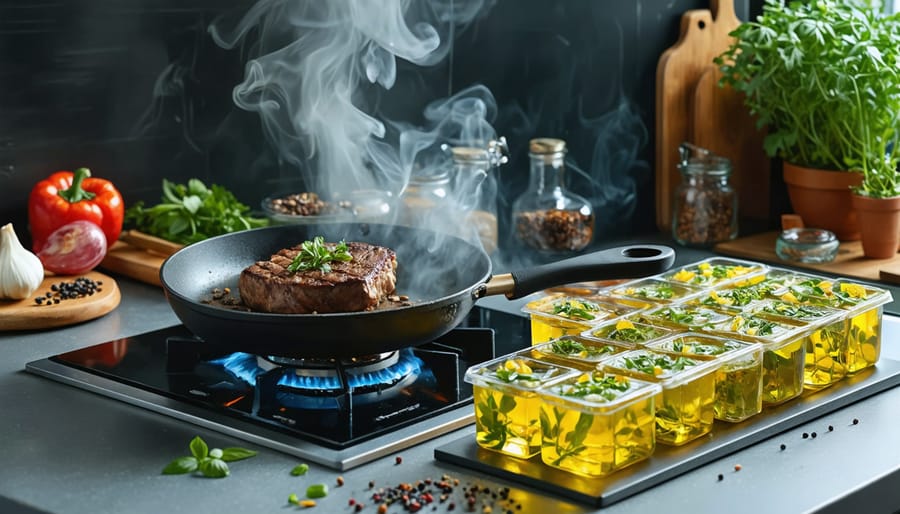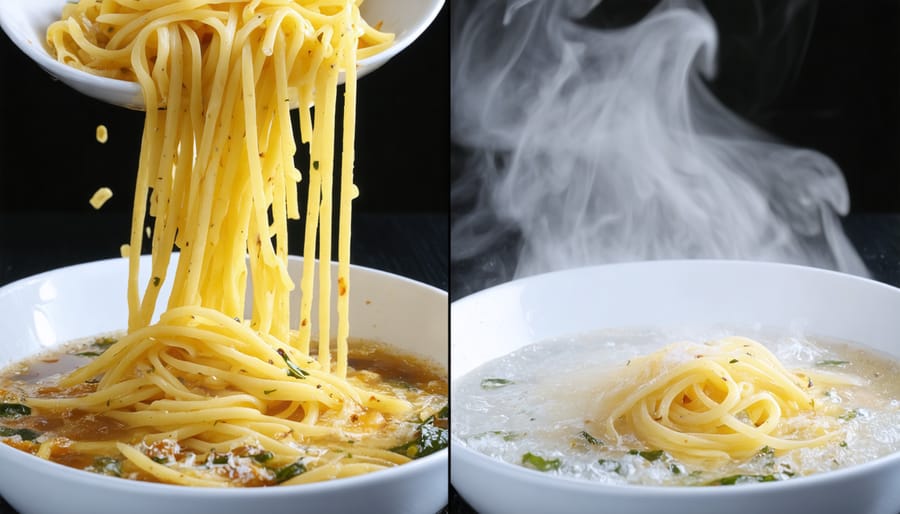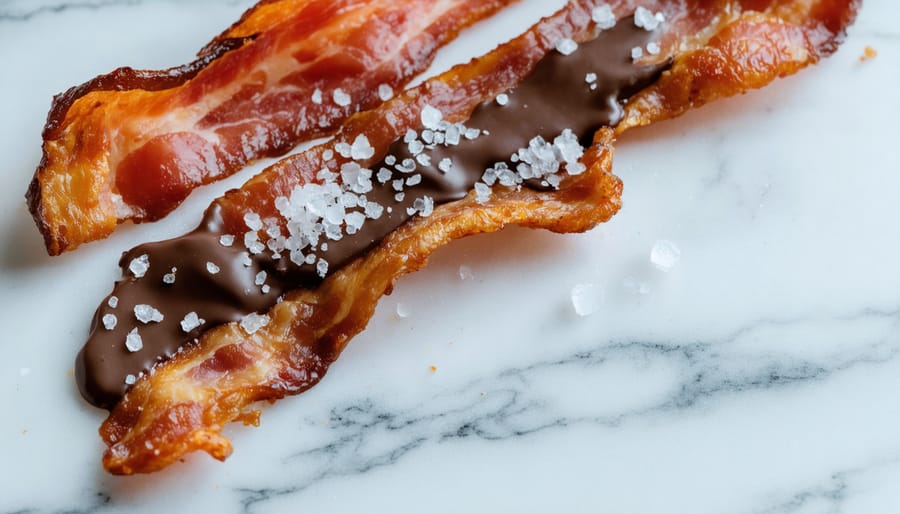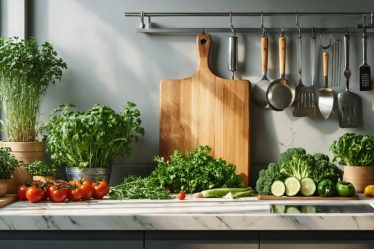
Transform your kitchen into a culinary laboratory with these unconventional mindful cooking techniques that challenge traditional methods. Smoke vegetables in a makeshift stovetop smoker using wood chips and a metal steamer basket, creating deep, complex flavors without specialized equipment. Reverse-sear thick steaks by slow-roasting at 250°F until nearly done, then finishing with a lightning-fast sear for restaurant-worthy results. Flash-freeze herbs in olive oil using ice cube trays to preserve their peak freshness and create instant flavor bombs for future dishes.
The world of innovative cooking stretches far beyond standard recipes and familiar methods. From using coffee grounds as a flavor-packed meat rub to fermenting everyday vegetables in mason jars, these unexpected techniques open up entirely new dimensions of taste and texture. Whether you’re an adventurous home cook or simply looking to breathe new life into your weekly meal prep, these methods will revolutionize your approach to everyday cooking. The best part? These techniques don’t require fancy equipment or professional training – just a willingness to experiment and think outside the conventional cooking box.
Surprising Temperature Techniques
Cold-Start Cooking Magic
Remember when your mom told you to always wait for the water to boil before adding pasta? Well, I’m about to share a game-changing secret: sometimes starting cold is the way to go! I discovered this technique during a hectic dinner party, and it’s completely transformed how I cook certain dishes.
Let’s start with pasta. Place your dried pasta in a pot, cover it with cold water, and turn on the heat. The pasta gradually warms up with the water, resulting in perfectly al dente texture and a starchier cooking liquid that’s fantastic for sauces. Plus, you’ll save time and energy since you’re not waiting for that pot to boil!
Cold-start vegetables are another revelation. Try placing whole carrots or green beans in a cold pan with a bit of butter and water. As they slowly heat up, they develop a gorgeous caramelization while maintaining their crisp texture. It’s like they’re getting the royal treatment!
For proteins, the cold-start method works wonders with salmon. Place your fillet in a cold pan, skin-side down, then gradually increase the heat. The skin turns wonderfully crispy while the flesh stays tender and moist. I learned this trick from my grandmother, who swore by starting everything cold for more even cooking.
Remember to experiment with these techniques – every kitchen is different, and finding what works best for you is part of the cooking adventure!

The Freezer’s Hidden Potential
Your freezer isn’t just for storing ice cream and frozen dinners – it’s a secret weapon for creating amazing culinary experiences! I discovered this game-changing approach when I accidentally left some grapes in the freezer, and they turned into nature’s most delightful little dessert bites.
Here’s the magic: freezing actually transforms certain foods in wonderful ways. Try freezing ripe bananas for the creamiest smoothies you’ve ever tasted, or pop fresh herbs in olive oil ice cubes for instant flavor bombs in your cooking. One of my favorite tricks is freezing leftover wine in an ice cube tray – perfect for deglazing pans or adding depth to sauces without opening a new bottle.
Did you know that freezing can actually enhance flavors? When you freeze tomatoes, the cell walls break down, intensifying their natural sweetness when they thaw. I love freezing summer berries at their peak – they release the most incredible juices when they defrost, making them perfect for baking or breakfast toppings.
For a show-stopping party trick, try semi-freezing cream before whipping – it’ll hold its shape better and create the most luxurious texture. And here’s a tip that changed my meal prep game: partially freeze meat before slicing for perfect, paper-thin cuts ideal for stir-fries or carpaccio.
Remember, your freezer isn’t just for preservation – it’s a tool for transformation!
Unexpected Ingredient Pairings
Sweet Meets Savory
Ever since I discovered the magic of sprinkling sea salt on dark chocolate, I’ve been fascinated by unexpected flavor pairings that somehow create culinary magic. The key lies in understanding how different taste elements can complement each other in surprising ways.
Take watermelon and feta cheese, for instance. The sweet, juicy fruit paired with salty, creamy cheese creates an explosion of flavors that dance on your tongue. Or consider the increasingly popular combination of maple syrup drizzled over fried chicken – a pairing that perfectly balances sweet and savory notes while adding an unexpected depth to a classic dish.
One of my favorite discoveries has been adding a pinch of espresso powder to chocolate-based recipes. The coffee doesn’t make the dish taste like your morning brew; instead, it intensifies the chocolate flavor in a way that leaves guests wondering about your secret ingredient. Similarly, a touch of cinnamon in savory meat dishes or a dash of cayenne in chocolate desserts can elevate familiar recipes to new heights.
Don’t be afraid to experiment with these unconventional combinations. Start small – perhaps by adding a drizzle of honey to your pizza crust or sprinkling some dark chocolate shavings over your chili. The beauty of these sweet-meets-savory combinations lies in their ability to transform ordinary dishes into memorable culinary experiences.

Secret Flavor Boosters
Have you ever wondered why some dishes at your favorite restaurants seem to have that extra special something? I discovered that professional chefs often rely on unexpected ingredients to elevate everyday recipes. Let me share some of these game-changing secret flavor boosters that’ll transform your home cooking.
A tiny splash of fish sauce in beef stews or bolognese sauce adds an incredible depth that’ll have everyone wondering about your secret ingredient. Don’t worry – it won’t taste fishy at all! Similarly, a spoonful of instant coffee in chocolate desserts intensifies the cocoa flavor beautifully.
When exploring creative ingredient substitutions, I’ve found that miso paste works wonders in creamy pasta sauces, adding a savory richness that butter alone can’t achieve. Another surprising addition is grated apple in meat marinades – the natural enzymes help tenderize the meat while adding subtle sweetness.
My personal favorite? A pinch of cinnamon in tomato-based dishes. It rounds out the acidity perfectly and adds warmth without being detectible. For vegetable dishes, try adding a splash of pickle juice to roasted vegetables just before serving – the bright, tangy notes will make the flavors pop in an unexpected way.
Remember, these additions should be subtle – you’re aiming for enhancement, not overwhelming the original dish. Start with small amounts and adjust to taste. Your family might just start requesting your “special” recipes more often!
Kitchen Tool Hacks
Beyond Their Intended Use
Who says your kitchen tools can only serve one purpose? I’ve discovered some delightfully unconventional ways to use everyday utensils that might make you look at your kitchen drawer differently. While there are plenty of innovative kitchen tools available today, sometimes the best solutions are hiding in plain sight.
Take your humble waffle maker, for instance. Beyond Sunday morning waffles, it’s fantastic for creating crispy hash browns, pressing paninis, and even making grilled cheese sandwiches. I recently used mine to make brownies, and the result was perfectly portioned squares with deliciously crispy edges!
Your coffee grinder isn’t just for beans – it’s perfect for creating fresh spice blends. I keep a separate one just for grinding whole spices, and the aromas are incredible. And that collecting dust slow cooker? Try using it as a gentle water bath for making perfect cheesecakes or custards.
One of my favorite discoveries was using a wine bottle as a rolling pin (in a pinch, it works beautifully!) and a clean spray bottle filled with olive oil for more controlled cooking surface coating. Even dental floss has found its way into my kitchen – it’s perfect for cutting soft cheeses and creating clean slices of roll cakes without squishing them.
Remember, creativity in the kitchen isn’t just about recipes; it’s about making the most of what you already have.

Makeshift Solutions
Ever found yourself in the middle of a recipe, desperately needing a specialized tool? Don’t worry – your kitchen is probably full of clever alternatives! I learned this lesson the hard way when preparing a fancy dinner party, only to realize I didn’t have a pastry cutter. A fork and some determination saved the day!
You’d be amazed at how many common items can double as cooking tools. Need a rolling pin? A wine bottle works perfectly (just make sure it’s clean!). No pastry brush? Fold a piece of parchment paper into a triangle for precise butter application. One of my favorite tricks is using a coffee filter as a fine-mesh strainer for small amounts of spices or powdered sugar.
For steaming vegetables without a proper steamer basket, try creating a makeshift version using aluminum foil. Simply crumple it into a ball, then flatten and poke holes in it – instant steamer! A sturdy mason jar can become an impromptu meat tenderizer, and a wine cork makes an excellent emergency bottle stopper.
My readers often share their own clever solutions: using dental floss for clean cake slicing, converting a colander into a salad spinner, or transforming chopsticks into cooking tongs. These creative alternatives not only save money but also prove that sometimes the best tools are hiding in plain sight.
Time-Bending Techniques
The Power of Patience
In our fast-paced world, there’s something magical about slowing down in the kitchen. I discovered this truth when I first experimented with 48-hour sous vide short ribs – the result was nothing short of revolutionary. The meat literally melted in my mouth, achieving a tenderness that quick cooking could never replicate.
One of my favorite slow-cooking techniques is the traditional French confit method. While most people associate it with duck, you can confit virtually any ingredient. I’ve had amazing results with garlic cloves slowly cooked in olive oil for four hours, transforming them into butter-soft golden nuggets that spread like jam.
Another game-changing technique is overnight fermentation for bread dough. Trust me, those extra hours make all the difference. The slow rise develops complex flavors and creates those gorgeous air pockets we all dream about in our homemade loaves. My community of home bakers often shares how this method has transformed their bread-making journey.
Don’t overlook the humble slow-roasted tomatoes either. Six hours at 200°F (93°C) concentrates their sweetness into something entirely new – I like to call them “tomato candy.” The patience required for these techniques might seem daunting at first, but think of it as cooking with intention rather than waiting. Your kitchen becomes a place of transformation, where time itself becomes an essential ingredient.
Speed Without Sacrifice
When life gets hectic, we often think we need to compromise on food quality for the sake of speed. But I’ve discovered some game-changing efficient cooking methods that prove otherwise. One of my favorite discoveries is the “cold-start” technique for cooking salmon – simply place the fish in cold oil and gradually heat it. This method prevents overcooking and results in perfectly tender fish every time.
Flash-brining is another time-saving miracle worker. By using hot brine for just 15 minutes instead of the traditional overnight soak, you can achieve incredibly juicy chicken breasts or pork chops. I was skeptical at first, but the results converted me instantly!
The reverse-sear method for steaks might sound counterintuitive, but it’s a game-changer for busy home cooks. Start your steak in a low-temperature oven, then finish with a quick sear. This approach gives you more control and consistently perfect results, even when you’re multitasking.
My personal favorite is the pressure-steaming combination technique. By adding just a splash of water to your pressure cooker, you can steam vegetables in record time while maintaining their nutrients and vibrant colors. The best part? You’ll get that perfect crisp-tender texture without hovering over the stove.
These methods prove that speed and quality aren’t mutually exclusive – it’s all about knowing the right techniques and timing.
As we’ve explored these unconventional cooking techniques, it’s clear that thinking outside the box in the kitchen can lead to incredible results. I remember being skeptical about cooking fish in my dishwasher (yes, really!) until I tried it and discovered perfectly poached salmon. These unusual methods aren’t just party tricks – they’re genuine tools that can enhance your culinary adventures and bring new life to familiar dishes.
By experimenting with these techniques, you’ll develop a deeper understanding of how heat, temperature, and cooking methods affect your food. Plus, you’ll have some fantastic conversation starters at your next dinner party! Whether you’re trying the coffee-rubbed steak technique or giving that microwave herb-drying method a go, each experiment builds your confidence and expands your cooking repertoire.
Don’t feel pressured to master everything at once. Start with one technique that intrigues you and gradually work your way through others as your comfort level grows. The beauty of these methods is that they encourage creativity and personal adaptation. Maybe you’ll even discover your own unique twist on these techniques!
Remember, some of the world’s most beloved cooking methods were once considered unusual. Who knows? The technique you try today might become tomorrow’s kitchen staple. So go ahead, embrace your culinary curiosity, and let these unconventional methods inspire your next kitchen adventure. After all, the most memorable meals often come from those moments when we dare to cook differently.



